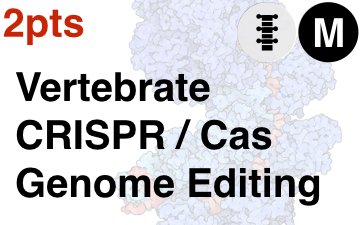Clustered regularly interspaced short palindromic repeats(CRISPR, pronounced crisper[2]) are segments of prokaryoticDNA containing short repetitions of base sequences. Each repetition is followed by short segments of “spacer DNA” from previous exposures to a bacteriophage virus or plasmid.[3]
The CRISPR/Cas system is a prokaryotic immune system that confers resistance to foreign genetic elements such as those present within plasmids and phages,[4][5][6] and provides a form ofacquired immunity. CRISPR spacers recognize and cut these exogenous genetic elements in a manner analogous to RNA interference in eukaryotic organisms.[3] CRISPRs are found in approximately 40% of sequenced bacterial genomes and 90% of sequenced archaea.[7][note 1]
By delivering the Cas9 nuclease and appropriate guide RNAs into a cell, the cell’s genome can be cut at a desired location, allowing existing genes to be removed and/or new ones added.[8][9][10]CRISPRs have been used in concert with specific endonucleaseenzymes for genome editing and gene regulation in species throughout the tree of life.[11]
Cas9 was the first nuclease discovered, followed by Cpf1, which was discovered in the CRISPR/Cpf1 system of Francisella novicida.[12][13]Other such systems are thought to exist.[14]
CRISPR/C2c2 from the bacterium Leptotrichia shahii is RNA-guided CRISPR system that targets RNA rather than DNA, and can either cleave single-stranded RNA targets or knock them down.[15]
The CRISPR interference technique has many potential applications, including altering the germline of humans, animals, and food crops. The use of CRISPR for genome editing[16][17] was the AAAS‘s choice for breakthrough of the year in 2015.[18] Bioethical concerns have been expressed about the prospect of using this nascent biotechnology for editing the human germline.[19]
(From: Wikipedia, June 2016)


